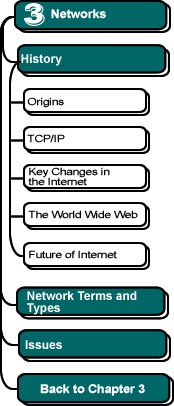

|
Key Changes
in the Internet
Thus, several important changes to the fundamental nature of the Internet occurred by 1985.
First, with the implementation of TCP/IP, the grounds were laid for both the growth and the diversification of the Internet. In our present era, where the only two personal computer platforms are "Mac" or "PC," it is hard to fully appreciate an era in which there were literally dozens and dozens of heterogeneous, incompatible computer makes and models. But in the 1970s and early 1980s, it was often impossible to standardize on a single make of computer: in such an expensive era of information technology, choices of computers often had to be made based on price rather than compatibility. As a result, the computers at a single university might be unable to connect to each other, let alone to computers at another university! Thus, the arrival of TCP/IP, a powerful means for completely incompatible computers systems to interface with each other, seemed nothing short of miraculous.
 The
Unix operating system had been developed at Bell Labs
in the 1970s. Unix was (and still is) a very stable and powerful multi-user
operating system. In 1984, the University of California at Berkeley released
a new version of Unix called "Berkeley" Unix, or BSD.
(The chosen mascot for BSD Unix was a demon—a play on the term daemon,
a software program that runs in the background). This
version of
Unix became an instant hit, especially in college and university computing.
Not only could this very affordable (often free) version of Unix run on
a great variety of computer platforms, enabling colleges and universities
to provide top-notch time-sharing of individual computers by
many users, but it also included a complete version of TCP/IP.
Thus, colleges and universities could connect their computer systems together
to create their own, smaller TCP/IP local area
networks. But this meant that they could also connect these small,
academic research networks into the NSFNet.
The
Unix operating system had been developed at Bell Labs
in the 1970s. Unix was (and still is) a very stable and powerful multi-user
operating system. In 1984, the University of California at Berkeley released
a new version of Unix called "Berkeley" Unix, or BSD.
(The chosen mascot for BSD Unix was a demon—a play on the term daemon,
a software program that runs in the background). This
version of
Unix became an instant hit, especially in college and university computing.
Not only could this very affordable (often free) version of Unix run on
a great variety of computer platforms, enabling colleges and universities
to provide top-notch time-sharing of individual computers by
many users, but it also included a complete version of TCP/IP.
Thus, colleges and universities could connect their computer systems together
to create their own, smaller TCP/IP local area
networks. But this meant that they could also connect these small,
academic research networks into the NSFNet.
Thus, the Internet had truly become an internetwork, a network made up of networks.
Moreover, the Internet was no longer restricted to defense-related research. Rather, any college or university that had legitimate research-related needs that could justify connection to the NSFNet was allowed to do so.
Thus, with the introduction of the NSFNet backbone, the Internet entered the next phase of its growth.
![]()
![]()
This chapter was written by Jeff Nyhoff and Joel Adams. Copy editing by
Nancy Zylstra
©2005 Calvin University (formerly Calvin College), All Rights Reserved
If you encounter technical errors, contact computing@calvin.edu.